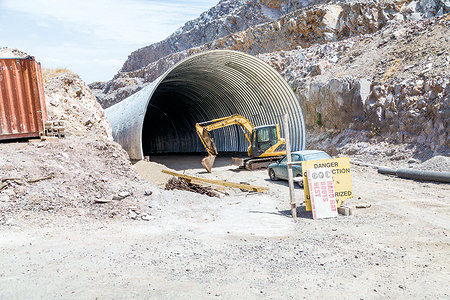26.B Hazardous Classifications.
26.B.01 Underground construction operations must be classified in accordance with the following.
- Underground construction operations must be classified as potentially gassy operations if either:
- (1) Air monitoring discloses 10% or more of the lower explosive limit (LEL) for methane or other flammable gases measured at 12 in +/- 0.25 in (30.4 cm +/- 0.6 cm) from the roof, face, floor, or walls for a period of more than 24 hours; or
- (2) The history of the geological area or geological formation indicates that 10% or more of the LEL for methane or other flammable gas is likely to be encountered.
- Underground operations must be classified as gassy operations if:
- (1) Air monitoring discloses 10% or more of the LEL for methane or other flammable gases measured at 12 in +/- 0.25 in (30.4 cm +/- 0.6 cm) from the roof, face, floor, or walls for three consecutive days; or
- (2) There has been an ignition of methane or other flammable gases emanating from the strata that indicates the presence of such gases; or
- (3) The underground construction operation is both connected to an underground work area that is currently classified as gassy and is also subject to a continuous course of air containing the flammable gas concentration.
26.B.02 Underground construction gassy operations may be downgraded to potentially gassy operations when air monitoring results remain under 10% of the LEL for methane or other flammable gases for 3 consecutive days.
26.B.03 Requirements for gassy operations.
- Only equipment approved for the hazardous location and maintained in suitable condition must be used in gassy operations.
- Mobile diesel-powered equipment used in gassy operations must be approved in accordance with the requirements of 30 CFR 36 by MSHA and State regulations and must be operated in accordance with these requirements and the manufacturer's instructions.
- Each entrance to a gassy operation must be prominently posted with signs notifying all entrants of the gassy classification.
- Smoking must be prohibited in all gassy operations and the employer must be responsible for collecting all personal sources of ignition, such as matches and lighters, from all persons entering a gassy operation.
- A permit is required and a fire watch must be maintained when hot work is performed. > See Section 9.
- Once an operation has been classified as gassy, all activities in the affected area (except those in (1) through (3), below) must be discontinued until the operation either is in compliance with all gassy operation requirements or has been downgraded to potentially gassy:
- (1) Activities related to the control of the gas concentration;
- (2) Installation of new equipment, or conversion of existing equipment, to comply with subparagraph (1), above; and
- (3) Installation of above-ground controls for reversing the air flow.
Knowledge Check Choose the best answer for the question.
26-5. When will an underground operation be considered a potentially gassy operation?
You forgot to answer the question!

